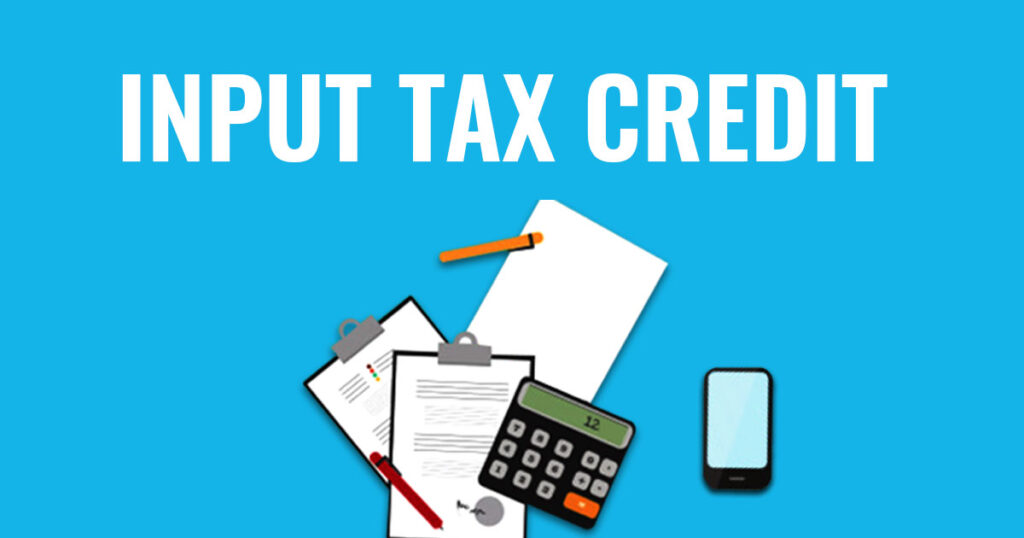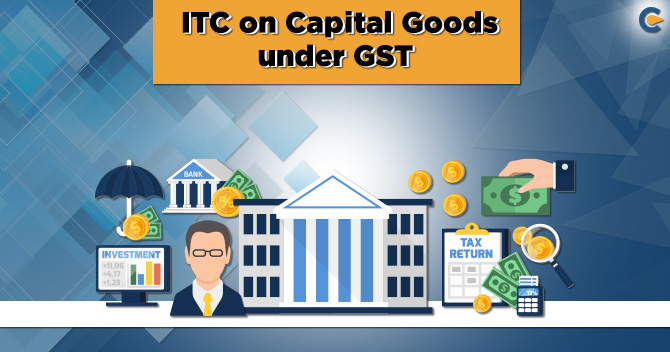Businesses use many capital goods on which input tax credit is available.The registered person who is involved in the export of goods or services or taxable supply or both can utilize qualified ITC on goods or services or both used in the development of the business. ITC can be utilized on inputs, input services, and capital goods.Input Tax Credit (ITC) reversal calculations, input tax credit availability and non-availability calculations, and input tax credit calculations for capital under GST each have their own unique special rules. Additionally, capital items that are utilized for both taxable and exempt deliveries are given special treatment. In this article, we examine the application of the GST’s input tax credit for capital goods in further depth, as well as the GST’s Input Tax Credit calculations

Meaning of Capital Goods as per CGST Act, 2017
The Section 2(19) provides for definition of capital goods. It provides, capital goods are those goods, values where of have been capitalized and are used or intended to be used in the course or in furtherance of business. Hence, capital goods which are not capitalized, that is to say, not debited to respective asset account, ITC in respect thereof, is not available to be taken credit.
However, Section 2(59) provides that “input” means any goods other than capital goods used or intended to be used in the course or in furtherance of business. It has implication that wherever word input is used, and not input tax, the same shall mean input other than capital goods.
Capital goods are regarded as items that assist in creating finished goods and preparing them for shipment. Many capital goods items use longer than one year. As a result, the cost may not apply as a business expense for the current year, and the deduction happens at set product usage lifetimes. Capital assets help the business or sector by generating goods.
Capital goods are assets such as buildings, machinery, equipment, vehicles and tools that an organization uses to produce goods or services. For example, a blast furnace used in the iron and steel industry is a capital asset for the steel manufacturer.
Difference between Capital Goods & Other Inputs
Goods utilized to create a finished product are known as input goods. In other words, input goods are many items combined to create a finished good. It may also be regarded as a component of the product’s manufacturing process. The price of making these raw items qualifies as a business expense.
Let us take an example. You are making a cake in your oven. You add ingredients such as eggs, water, flour, butter. These are your inputs. The cake is your final product. The oven is the capital good which helps you to make the cake. Inputs are consumed while making the final product and are treated as business expenses as cost of production.
Capital goods are not consumed when the final product is made. They are not consumed in a single year of production. Therefore, they cannot be entirely deducted as business expenses in the year of their purchase. Instead, they are depreciated over the course of their useful lives. The business recognises part of the cost each year through accounting techniques as depreciation, amortization and depletion.
What is Credit on Capital Goods?
So, you’ve invested in that shiny new machinery. The good news? You’re eligible for a sweet deal—the Input Tax Credit on Capital Goods. This credit allows businesses to offset taxes paid on capital goods against their output tax liability.
When you purchase anything, you are required to pay GST on it. Later, you can claim input tax credit on the GST paid on your purchases. Similarly, when you are purchasing any machinery for your factory, you will pay the applicable GST rate. This GST paid can be claimed as credit in the same way as inputs. However, if you claim depreciation on the GST paid while purchasing the capital asset, you cannot claim input tax credit.

Concept of Common Credit
Businesses often use the same assets and inputs for both business & personal use. For example, Ms. shruti is a freelance designer and Youtube blogger . She has a personal Desktop which she also uses for her freelance work. She can claim the input credit of GST paid on purchase of Desktop only to the extent it pertains to her freelance business. Ms. shruti has also purchased a special designing software. Since this pertains only to her business, she can claim full ITC on this.
Common Credit: The Concept
1.The Unity Principle:Common Credit pools the credits of both inputs and capital goods. A unified approach for streamlined taxation.
2.Crossing Borders:Applicable when a business has multiple units across states.Ensures seamless credit utilization.
Why is common credit important?
Financial Fluidity:
- Smooth cash flow as taxes paid on capital goods find purpose.
- Empowers businesses to invest in growth.
Reduction in Tax Burden:
- Common Credit mitigates the tax burden on the end consumer.
- A win-win for businesses and customers alike.
ITC is only offered for commercial use. The same inputs are used by many traders for both professional and personal purposes. Taxpayers are not permitted to deduct personal costs from their taxes. Once more, products that are exempt from GST already pay 0% GST.
ITC claims for inputs used in certain exempt items are not permitted since doing so would result in negative taxes. ITC on inputs for exempted items would thus be eliminated as well.
Input Tax Credit on Capital Goods
All individuals who have registered for the GST are permitted to get input tax credits, according to Section 16 of the CGST Act (ITC). The registered person is eligible to use the ITC for company expansion or other related reasons. When purchases of capital items are made solely for business use, and when GST’s input tax credit is applicable. The taxpayer must document the business transaction when completing the GST return in order to receive the input tax credit for capital goods.
Use of Capital Goods for both Personal Use and Exempt Sales
Personal Use Pitfall:
- ITC not available if capital goods are used for personal consumption.
- A reminder to keep business and personal domains distinct.
Exempt Sales Exception:
- ITC available if capital goods are used for exempt sales.
- A silver lining for businesses involved in exempted transactions.
Calculating Input Tax Credits for Capital Goods
According to Section 16(3), the following method of computation must be applied for capital items that are subject to GST under Sections 17 (1) and (2), even if such products are partially utilized for other purposes or to make taxable supply, including zero-rated ones:
- If the taxpayer exclusively utilizes or uses the capital goods (in relation to the input tax credit) for non-business reasons, this information should be recorded in the transaction and indicated in Form GSTR-2 and Form GSTR-3B.
- In the computerized credit ledger, the amount must not be credited. Forms GSTR-2 and GSTR-3B shall indicate any capital goods utilized by the taxpayer in connection with the input tax credit when producing taxable supply, including zero-rated supplies. The sum must be recorded in the digital credit ledger. This will take effect in accordance with rule 43(1) (b) of the CGST Rules and Schedule II paragraph 5(b) of the same Act.
- Any items marked A that are not covered by clauses (a) and (b) will have a five-year life expectancy. The sum must be added to the digital credit ledger.
- In the event that the identical capital goods are covered by clauses (a) and (c), the taxpayer may determine the value of “A” by subtracting the input tax at a rate of 5% for each quarter. The value must be added to the computerized credit ledger once the ITC has been subtracted.
- If the taxpayer produces capital goods that fall under these clauses, Section 18(4) of the CGST Act’s need for ITC reversal will not be necessary. The ITC has already been subtracted; hence the reversal shall not apply.
Sale of Capital Goods
Section 18 of the CGST Act specifies the requirements and limitations that apply to the sale of capital goods and the supply of commodities for which the following input tax credit has been claimed:
- A sum equivalent to the input tax credit claimed for the aforementioned capital items or equipment, reduced by the percentage specified in Rule 44(6); or
- Whichever is larger, the tax on the transaction value of such capital goods or plant and machinery is defined by section 15.
According to regulation 44(6), the input tax credit for capital items held in stock that have a remaining useful life of more than six months must be calculated pro rata, assuming a five-year useful life
Reversal of credit under certain circumstances
In the following circumstances the proportionate ITC will be reversed i.e. added to output tax liability in GSTR-3B:
- Where a normal taxpayer opts to pay tax under composition scheme or goods/services supplied by him become exempt
- In case of supply of capital goods or plant and machinery, on which input tax credit has been taken
- Every registered person whose registration is cancelled
Input tax credit involved in the remaining useful life in months shall be computed on a pro-rata basis, taking the useful life as five years.
This must be accompanied by a certificate from a practicing chartered accountant or cost accountant. In case of sale of capital goods, if the amount determined above is greater than the tax on transaction value of such sale, then the amount determined as above will be added to output tax liability. The details must be furnished in FORM GSTR-1.
FAQs
Q1: Is Common Credit applicable to all businesses?
A1: Yes, businesses with multiple units across states can leverage Common Credit for seamless tax utilization.
Q2: Can I claim Input Tax Credit on Capital Goods used for personal purposes?
A2: No, Input Tax Credit is not available for capital goods used for personal consumption. It is restricted to business use.
Q3: Is there a penalty for not reversing Input Tax Credit after the sale of Capital Goods?
A3: Yes, non-compliance can lead to penalties. It is essential to reverse Input Tax Credit to maintain regulatory compliance.
Q4: Is Common Credit applicable to all businesses?
A4: Yes, Common Credit is applicable to businesses with multiple units across states, facilitating seamless tax utilization and compliance.
Practice area's of B K Goyal & Co LLP
Income Tax Return Filing | Income Tax Appeal | Income Tax Notice | GST Registration | GST Return Filing | FSSAI Registration | Company Registration | Company Audit | Company Annual Compliance | Income Tax Audit | Nidhi Company Registration| LLP Registration | Accounting in India | NGO Registration | NGO Audit | ESG | BRSR | Private Security Agency | Udyam Registration | Trademark Registration | Copyright Registration | Patent Registration | Import Export Code | Forensic Accounting and Fraud Detection | Section 8 Company | Foreign Company | 80G and 12A Certificate | FCRA Registration |DGGI Cases | Scrutiny Cases | Income Escapement Cases | Search & Seizure | CIT Appeal | ITAT Appeal | Auditors | Internal Audit | Financial Audit | Process Audit | IEC Code | CA Certification | Income Tax Penalty Notice u/s 271(1)(c) | Income Tax Notice u/s 142(1) | Income Tax Notice u/s 144 |Income Tax Notice u/s 148 | Income Tax Demand Notice
Company Registration Services in major cities of India
Company Registration in Jaipur | Company Registration in Delhi | Company Registration in Pune | Company Registration in Hyderabad | Company Registration in Bangalore | Company Registration in Chennai | Company Registration in Kolkata | Company Registration in Mumbai | Company Registration in India | Company Registration in Gurgaon